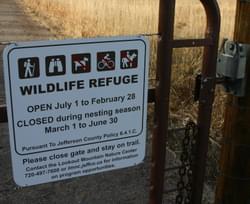




Planning Trails with Wildlife in Mind
Many longer trails cross from one jurisdiction to another. This has ramifications for how the trail is planned and specifically how wildlife issues are considered.

If a trail will cross federal lands, a more careful environmental analysis may be required. Federal agencies, such as the USDA Forest Service and the Bureau of Land Management have their own environmental review processes in most cases. These agencies also have land management plans that identify where they believe trails should and should not go.
It is important early on in a trails project to contact the federal, state, and local agencies with jurisdiction over lands you are considering. This is not just because they manage the land and have the ultimate say as to what happens, but also because they most likely have important wildlife information and knowledgeable experts.
The National Environmental Policy Act (NEPA) outlines an environmental review process for reviewing projects proposed with federal lands or funds. NEPA can seem intimidating to those first encountering it. (Contact the manager of the federal property early in the process for advice.) Because the NEPA process would have been followed for an adopted federal forest or other land management plan, it may be possible that additional environmental review is not needed for a specific trail project. Often reconstruction or minor trail rerouting may be approved under existing NEPA documentation, without the need for additional review.
In general, the smaller and less intrusive the trail project on federal lands, the quicker the environmental review. The public scoping process (by which issues and concerns are identified) may be more lengthy if a trail is perceived as controversial.
As early in the trail planning process as feasible, contact the owners of private lands in the general area of your proposed trail. Out of respect for private property, it is good to communicate with these community members from the beginning of the project.
L.1 Existing plans.
Propose trails on federal lands in areas identified as suitable in existing management plans.
L.2 Additional requirements.
ScBe prepared to follow a more formal environmental review process if you are proposing a trail on federal land. You may want to start working with the responsible agency a year in advance of proposed construction.
L.3 Practical advice.
Interview a person who already has been through the NEPA process for a trail project similar to yours. (Talk with the Bureau of Land Management or U.S. Forest Service, for example.).
Typical information needed for trail system analysis on lands managed by the USDA Forest Service includes:
1. Is there an approved plan for the area?
2. What are the general goals of the Forest Plan as they relate to the area?
3. What specific Forest Plan management objectives and prescriptions have been designated for the area? What other resource activities are likely to take place?
4. Within those prescriptions, what standards and guidelines might affect trail system design, operation, and administration?
[Older publications may be available from libraries and used booksellers. Titles with links may still be in print.]
Shipley Environmental, Applying the NEPA Process. Telephone: 801-298-7800.
Sustaining Wildlife With Recreation on Public Lands
posted Nov 25, 2023
Humans and wildlife interact in multifaceted ways on public lands with both positive and negative outcomes for each group. When managed well, wildlife-based tourism and other forms of recreation can benefit conservation goals.
Environmental Impacts of Winter Recreation
posted Nov 25, 2023
Regardless of our intentions, many species perceive humans as a threat and respond accordingly. In general, animals respond to threats by first increasing vigilance (time spent looking around versus foraging), and running away if the threat is perceived to be imminent.
posted Nov 24, 2023
Winter recreation is a rapidly growing activity, and advances in technology make it possible for increasing numbers of people to access remote backcountry terrain. Increased winter recreation may lead to more frequent conflict between recreationists, as well as greater potential disturbance to wildlife.
Guidelines for Managing and Restoring Natural Plant Communities along Trails and Waterways
posted Sep 18, 2023
These guidelines are designed to assist resource managers in conducting management activities that enhance the quality of natural plant communities, wildlife habitat, regional landscape integrity and visual quality, particularly as related to planning, development, and maintenance of trails, water trails, and water access sites.
887 views • posted 09/08/2018